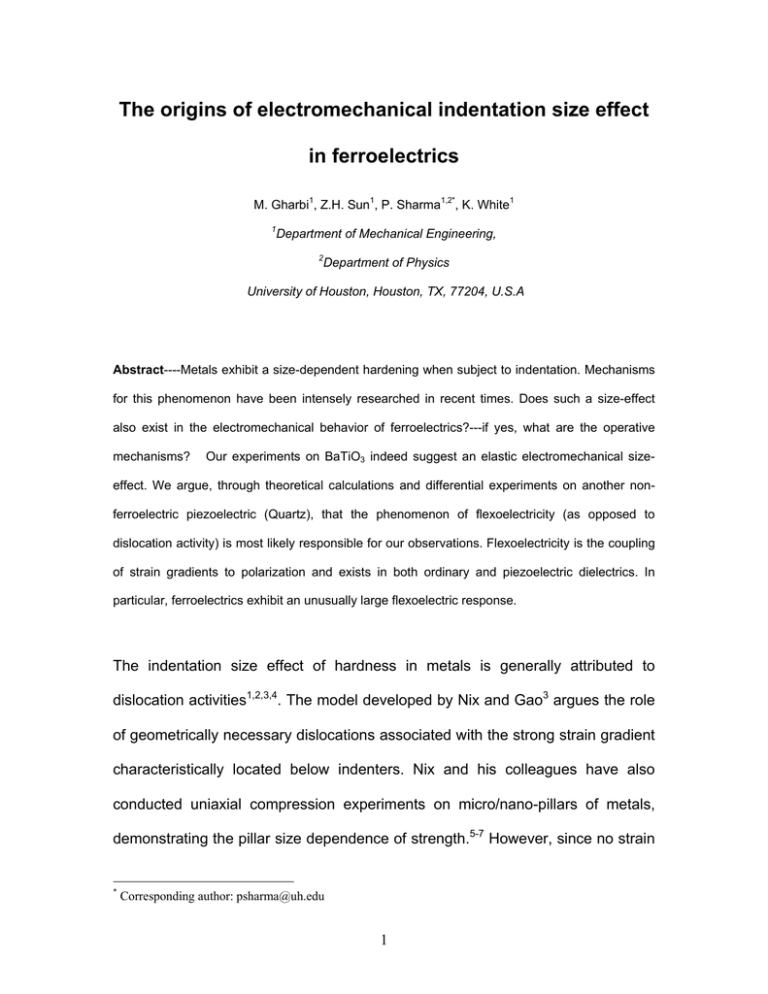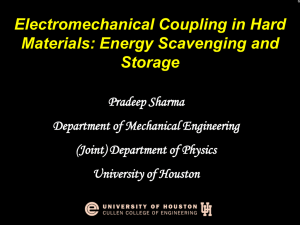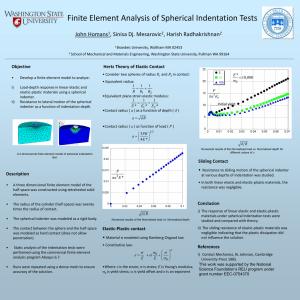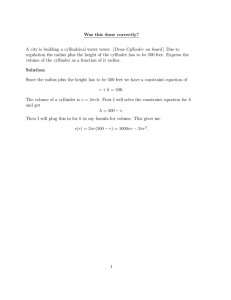The origins of electromechanical indentation size effect in ferroelectrics
advertisement

The origins of electromechanical indentation size effect in ferroelectrics M. Gharbi1, Z.H. Sun1, P. Sharma1,2*, K. White1 1 Department of Mechanical Engineering, 2 Department of Physics University of Houston, Houston, TX, 77204, U.S.A Abstract----Metals exhibit a size-dependent hardening when subject to indentation. Mechanisms for this phenomenon have been intensely researched in recent times. Does such a size-effect also exist in the electromechanical behavior of ferroelectrics?---if yes, what are the operative mechanisms? Our experiments on BaTiO3 indeed suggest an elastic electromechanical size- effect. We argue, through theoretical calculations and differential experiments on another nonferroelectric piezoelectric (Quartz), that the phenomenon of flexoelectricity (as opposed to dislocation activity) is most likely responsible for our observations. Flexoelectricity is the coupling of strain gradients to polarization and exists in both ordinary and piezoelectric dielectrics. In particular, ferroelectrics exhibit an unusually large flexoelectric response. The indentation size effect of hardness in metals is generally attributed to dislocation activities1,2,3,4. The model developed by Nix and Gao3 argues the role of geometrically necessary dislocations associated with the strong strain gradient characteristically located below indenters. Nix and his colleagues have also conducted uniaxial compression experiments on micro/nano-pillars of metals, demonstrating the pillar size dependence of strength.5-7 However, since no strain * Corresponding author: psharma@uh.edu 1 gradient is involved in these experiments, a different mechanism, dislocation starvation hardening, was proposed,6 although the exact origins are still an active area of research.8 In ferroelectrics also, increasing hardness with decreasing indenter radius has been observed for both PZT as well as BaTiO3.9,10 Although, Schneider and his colleagues reported the elastic modulus to be independent of indenter radius, the absence of contact stiffness versus contact radius curves for each indenter limits any direct comparison with our work. In the present work we pay careful attention to how the elastic behavior changes in ferroelectrics as a function of indent size. Although the elastic properties of ordinary metals and ceramics11 are nearly size-independent down to a few nanometers, ferroelectrics12 and certain amorphous materials11 may prove exception to the rule. The so-called elastic indentation size-effect is nicely illustrated by our experiments on BaTiO3 (001) oriented single crystals ( 5 × 5 × 1 mm). A series of nanoindentations with a Berkovich indenter provided the contact stiffness versus contact radius curve (s-a curve) for comparison with the theoretically computed s-a curve for a circular flat indenter of various indenter radii. Considering the geometry-independent stiffness and contact radius relationship in the case of purely mechanical loading, the s-a curve for Berkovich indenter can be experimentally obtained in a single experiment. Since it is difficult to manufacture and maintain a conical indenter with a sharp tip, the reliable data in the smallscale can not be obtained. Therefore, we adopted a sharp Berkovich indenter 2 (three-sided pyramid, the tip radius ~50 nm) at the expense of well-defined contact radius. The area function of the indenter tip, A = f (hc ) was carefully calibrated using standard procedures,13 where hc is the contact depth. Although the projected contact area is not circular for the Berkovich indenter, the effective contact radius is calculated from the contact area by π a 2 = f (hc ) and this approximation is quite good for small depths. On the theoretical side, Karapetian el al.’s14 have provided a detailed model of piezoelectric indentation. Within the assumption of transverse isotropy and restriction of indenter shape to be a cylinder, they interrelate applied concentrated force P , concentrated charge Q , indentation depth w and tip potentialψ 0 : P= 2aC1* w π + 2aC3*ψ 0 + 2aC ψ 0 π (1) Q= * 2 2aC w π * 4 π s=2 The contact stiffness, under purely mechanical loading is: C1* π a We note here that C1* is not just the elastic modulus but a combination of elasticity, piezoelectric and dielectric tensor components. The important aspect to keep in mind is that contact stiffness varies linearly with “a” or alternatively the ratio of contact stiffness to contact radius is a size-independent “constant”. We note that a similar relation is obtained for indentation on elastically isotropic half 3 spaces,13,15 C1* is π Er , where Er is the reduced elastic modulus. This stiffness relation was derived for an axisymmetric indenter (circular contacts), however, it has been shown that it works well even for the non-axisymmetric shapes, provided a small correction factor is used.13,15 In Figure (1) we plot both our experimental results as well as the results from the aforementioned model based on classical piezoelectricity. Figure 1: Variation of the ratio of the contact stiffness and contact radius with respect to the contact radius a for BaTiO3. The inset graph plots the contact stiffness versus radius. From Figure (1) two points are well-evident: (i) our experiments suggest a strong indentation size-effect. (ii) classical piezoelectricity, as anticipated from the model based on classical piezoelectricity14, fails to capture this. We may be tempted to resort to dislocations based arguments to explain this size-effect. Our theoretical 4 analysis (to follow) however hints towards another explanation, namely, flexoelectricity. Piezoelectricity requires that the crystalline unit cell lack centro-symmetry (for example NaCl is not piezoelectric while BaTiO3 is). An underappreciated fact is that in the presence of inhomogeneous strain, inversion symmetry can be broken leading to the development of polarization even in non-piezoelectric materials. ( P )i = ( d )ijk ( ε ) jk + ( f )ijkl ∇l (ε ) jk (2) where d is the third order piezoelectric tensor and f is the fourth order flexoelectric tensor. This is well illustrated for graphene through ab initio simulation under bending (which is manifestly non-piezoelectric)---e.g. Ref. 16. Recently one of us has clarified some of the basic mechanisms behind flexoelectricity as well as evaluated flexoelectric properties through atomistic calculations17. Other very interesting works have also appeared. Experiments on finding flexoelectric properties were pioneered by Cross and co-workers18 who have established that flexoelectric constants are three orders of magnitude larger than ordinary dielectrics. Zubko19 have recently published the experimental characterization of the complete flexoelectric tensor of SrTiO3. The two papers by Catalan et. al.20,21 describe the impact of flexoelectricity on properties of ferroelectric thin films while a more recent work22 provides some interesting insights into the role of intrinsic strain gradients invariably present in ferroelectric nanostructures (e.g. nanoparticles). Recently, we have shown the prospects of 5 enhanced piezoelectricity in nanostructures12 due to flexoelectricity, its role in the origins of the dead-layer in ferroelectric based nanocapacitors23 and underscored Cross’s idea24 of the possibility of creating apparently piezoelectric materials without using piezoelectric materials25. In prior work we have presented a mathematical formulation of the theory of flexoelectricity26. The equations are quite complicated even for an isotropic continuum let alone a anisotropic crystal which also exhibits direct piezoelectricity (as is the case for BaTiO3). Nevertheless we, employing a perturbation approach coupled with guidance from some partial numerical calculations, have been successful in generating closed form expression for the effect of flexoelectricity on indentation. Details of the model itself will be presented elsewhere27,28. To summarize, we find the following (for purely mechanical loading): ⎞ 2 * ε ⎛ −A a P= C w− f1 w i 2 ⎜ ε e ε − ε + Ai a ⎟ ⎟ ( A ) ⎜⎝ π πa ⎠ 2a i * 1 (3) The ratio of the contact stiffness to the contact radius is then: ⎞ s 1 ∂P 2 * 2 f1* ε ⎛ − Aε a = = C1 − 2 i 2 ⎜ ε e − ε + Ai a ⎟ ⎟ a a ∂w π π a ( A ) ⎜⎝ ⎠ i (4) size − effect where Ai and f1* are constants depending on material properties and ε is the approximate value of flexoelectric and piezoelectric ratio. Equation (3) shows the presence of a size-effect due to flexoelectricity (underlined terms). The results embodied in equations (3-4) ignore some of the intrinsic polarization gradient 6 effects alluded to by Catalan et. al.20,21 and Eliseev et. al.22. Given the large strain gradients caused by the indentation process relative to the intrinsic mechanisms, this approximation is justified in the present case (although certainly future work should explore the correction if any that would result from incorporating that effect). Experiments of Cross18 indicate that flexoelectric coefficients are quite large for BaTiO3 and thus we anticipate flexoelectricity to contribute significantly. However, can other mechanisms such as dislocation hardening be ruled out? While the latter is a complex problem, two simple steps (one qualitative argument and the other a simple differential experiment) can help provide some insight. Quartz is not expected to exhibit a widely different dislocation activity from BaTiO3, on the other hand, its flexoelectric properties are nearly 3 orders of magnitude lower than that of BaTiO3. Accordingly, we also carried out an identical set of indentation experiments on Quartz following essentially the same procedure as that for BaTiO3. Comparisons of our flexoelectricity based model with both our experiments are shown in Figure (2). 7 Figure 2: Variation of the ratio of the contact stiffness and contact radius as a function of contact radius. Experimental results for both BaTiO3 and Quartz are plotted along with the results from the flexoelectricity and classical piezoelectricity based models. As well-evident from Figure (2), the agreement between our model and experiments is quite close---remarkable since there is no “fitting or calibration” performed between our theoretical/computational model and experiments. Quartz shows no size-effect in the experiments, and is clearly anticipated by our model since the flexoelectric constants are quite small for this material (i.e. the underlined term in Equation 3 is essentially zero in the range of contact sizes shown in Figure 2). The role of mechanisms such as domain wall activity, dislocation based mechanisms among others to explain the observed electromechanical size-effect cannot be conclusively ruled out based solely on the work presented here. Certainly domain activities are absent in Quartz. However, the argument that 8 Quartz has low flexoelectricity and coupled with the fact that we are emphasizing elastic behavior as well as the close agreement of our model with experiments indicates that flexoelectricity is most likely the dominant mechanism behind the observed size-effect. Further, recent experiments by Luk’yanchuk et al.29 suggest a change in surface hardness as well which could very well be related to the present study. Acknowledgements: We acknowledge financial support from the NSF under NIRT Grants No. CMMI 0708096 and No. CMMI 0826153. References 1. N.A. Stelmashenko, M.G. Walls, L.M. Brown, and Y.V. Milman, Acta Metallurgica et Materialia 41, 2855 (1993). 2. Q. Ma and D.R. Clarke, Journal of Materials Research 10, 853 (1995). 3. W.D. Nix and H.J. Gao, J. Mech. Phys. Solids 46, 411 (1998). 4. J.G. Swadener, E.P. George, and G.M. Pharr, Journal of the Mechanics and Physics of Solids 50, 681 (2002). 5. M.D. Uchic, D.M. Dimiduk, J.N. Florando, and W.D. Nix, Science 305, 986 (2004). 6. J.R. Greer, W.C. Oliver, and W.D. Nix, Acta mater. 53, 1821 (2005). 7. J.R. Greer and W.D. Nix, Physical Review B 73, 245410 (2006). 8. J.R. Greer, C.R. Weinberger, and W. Cai, Materials Science and Engineering A 493, 21 (2008). 9. T. Scholz, J. Muñoz-Saldaña, M.V. Swain, and G.A. Schneider, Appl. Phys. Lett. 88, 091908 (2006) 9 10. A. Hurtado-macias, J. Muñoz-Saldaña, F.J. Espinoza-Beltran, T. Scholz, M.V. Swain, and G.A. Schneider, J. Phys. D: Appl. Phys. 41, 035407 (2008). 11. R. Maranganti, and P. Sharma, Phys. Rev. Lett. 98, 195504 (2007). 12. M. S. Majdoub, P. Sharma, and T. Cagin, Phys. Rev. B 77, 125424 (2008); M. S. Majdoub, P. Sharma, and T. Cagin, Phys. Rev. B 79, 1(E) (2009). 13. W.C. Oliver and G.M. Pharr, J. Mater. Res. 7, 1564 (1992). 14. E. Karapetian, M. Kachanov, and S.V. Kalinin, Philosophical Magazine 85:10, 1017-1051 (2005). 15. G.M. Pharr, W.C. Oliver, and F.R. Brotzen, J. Mater. Res. 7, 613 (1992). 16. T. Dumitrica, C. M. Landis, and B. I. Yakobson, Chemical Physics Letters 360, 182 (2002). 17. R. Maranganti, and P. Sharma, arXiv:0903.0684 (unpublished). 18. W. Ma, and L. E. Cross, Appl. Phys. Lett. 88, 232902 (2006). 19. P. Zubko, G. Catalan, P. R. L. Welche, A. Buckley, and J. F. Scott, Phys. Rev. Lett. 99, 167601 (2007). 20. G. Catalan, L.J. Sinnamon, J.M. Gregg, J. Phys.: Condens. Matter 16, 2253-2264 (2004). 21. G. Catalan, B. Noheda, J. McAneney, L.J. Sinnamon, and J.M. Gregg, Phys. Rev. B 72, 020102(R) (2005). 22. E.A. Eliseev, A.N. Morozovska, M.D. Glinchuk, and R. Blinc,, Phys. Rev. B 79, 165433 (2009). 10 23. M. S. Majdoub, R. Maranganti, and P. Sharma, Phys. Rev. B 79, 115412 (2009). 24. J. Fousek, L.E. Cross, and D.B. Litvin, Materials Letters 39, 287–291 (1999). 25. N.D. Sharma, R. Maranganti, and P. Sharma, Journal of the Mechanics and Physics of Solid 55, 2328–2350 (2007). 26. R. Maranganti, N.D. Sharma, and P. Sharma, Phys. Rev. B 74, 014110 (2006). 27. M. Gharbi, Z.H. Sun, P. Sharma, K. White, and S. EL-Borgi, unpublished. 28. See EPAPS supplementary material at [URL will be inserted by AIP] for details of derivation of the flexoelectric model. 29. I.A. Luk’yanchuk, A. Schilling, J.M. Gregg, G. Catalan, and J.F. Scott, Phys. Rev. B 79, 144111, (2009). 11



